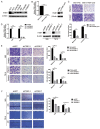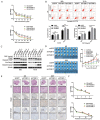Integrin β1 is a critical effector in promoting metastasis and chemo-resistance of esophageal squamous cell carcinoma
- PMID: 28401009
- PMCID: PMC5385641
Integrin β1 is a critical effector in promoting metastasis and chemo-resistance of esophageal squamous cell carcinoma
Abstract
Metastasis of esophageal squamous cell carcinoma (ESCC) remains a challenge in clinical practice. In this study, we clarified that integrin β1 (ITGB1) plays critical roles in the metastasis of ESCC. By analyzing the expression of integrin β1 in ESCC specimens, we found that the expression of this integrin was higher in malignant than in normal tissues and that this increase was associated with lymph node metastasis. Moreover, in vitro functional experiments demonstrated that deletion of integrin β1 impaired the motility of ESCC cells, and we also showed that integrin β1 deletion significantly inhibited metastases formation in the lungs and lymph nodes of two murine models. Mechanistically, integrin β1 promoted cellular motility by regulating the FAK-Rac1 signaling pathway. Finally, we found that blocking integrin β1 significantly impaired the resistance of ESCC cells to cisplatin (DDP) treatment based on in vitro and in vivo experiments. Overall, our data suggest that integrin β1 promotes metastasis and confers DDP resistance to ESCC, which provides experimental evidence for targeting this protein to treat ESCC in the future.
Keywords: FAK; Integrin β1; chemo-resistance; esophageal cancer; metastasis.
Figures





Similar articles
-
USP10 promotes migration and cisplatin resistance in esophageal squamous cell carcinoma cells.Med Oncol. 2023 Dec 27;41(1):33. doi: 10.1007/s12032-023-02272-7. Med Oncol. 2023. PMID: 38150085
-
Role of Integrin β1 in the progression and chemo-resistance of esophageal squamous cell carcinoma.J Cancer. 2022 Mar 28;13(7):2074-2085. doi: 10.7150/jca.68647. eCollection 2022. J Cancer. 2022. PMID: 35517416 Free PMC article.
-
Macrolide analog F806 suppresses esophageal squamous cell carcinoma (ESCC) by blocking β1 integrin activation.Oncotarget. 2015 Jun 30;6(18):15940-52. doi: 10.18632/oncotarget.3612. Oncotarget. 2015. PMID: 25909284 Free PMC article.
-
Integrin α6 promotes esophageal cancer metastasis and is targeted by miR-92b.Oncotarget. 2017 Jan 24;8(4):6681-6690. doi: 10.18632/oncotarget.14259. Oncotarget. 2017. PMID: 28036265 Free PMC article.
-
Integrin β1 in Pancreatic Cancer: Expressions, Functions, and Clinical Implications.Cancers (Basel). 2022 Jul 11;14(14):3377. doi: 10.3390/cancers14143377. Cancers (Basel). 2022. PMID: 35884437 Free PMC article. Review.
Cited by
-
Effect of Wenxia Changfu Formula Combined With Cisplatin Reversing Non-Small Cell Lung Cancer Cell Adhesion-Mediated Drug Resistance.Front Pharmacol. 2020 Sep 17;11:500137. doi: 10.3389/fphar.2020.500137. eCollection 2020. Front Pharmacol. 2020. PMID: 33041787 Free PMC article.
-
Restoration of microRNA-29c in type I endometrioid cancer reduced endometrial cancer cell growth.Oncol Lett. 2019 Sep;18(3):2684-2693. doi: 10.3892/ol.2019.10588. Epub 2019 Jul 9. Oncol Lett. 2019. PMID: 31404303 Free PMC article.
-
Integrin α5 promotes migration and cisplatin resistance in esophageal squamous cell carcinoma cells.Am J Cancer Res. 2019 Dec 1;9(12):2774-2788. eCollection 2019. Am J Cancer Res. 2019. PMID: 31911861 Free PMC article.
-
miR-30b-5p acts as a tumor suppressor microRNA in esophageal squamous cell carcinoma.J Thorac Dis. 2019 Jul;11(7):3015-3029. doi: 10.21037/jtd.2019.07.50. J Thorac Dis. 2019. PMID: 31463131 Free PMC article.
-
Identification of novel candidate biomarkers for pancreatic adenocarcinoma based on TCGA cohort.Aging (Albany NY). 2021 Feb 11;13(4):5698-5717. doi: 10.18632/aging.202494. Epub 2021 Feb 11. Aging (Albany NY). 2021. PMID: 33591944 Free PMC article.
References
-
- Torre LA, Bray F, Siegel RL, Ferlay J, Lortet-Tieulent J, Jemal A. Global cancer statistics, 2012. CA Cancer J Clin. 2015;65:87–108. - PubMed
-
- Rustgi AK, El-Serag HB. Esophageal carcinoma. N Engl J Med. 2014;371:2499–2509. - PubMed
-
- Gupta GP, Massague J. Cancer metastasis: building a framework. Cell. 2006;127:679–695. - PubMed
-
- Hynes RO. Integrins: bidirectional, allosteric signaling machines. Cell. 2002;110:673–687. - PubMed
-
- Itou J, Tanaka S, Li W, Iida A, Sehara-Fujisawa A, Sato F, Toi M. The Sal-like 4-integrin alpha6beta1 network promotes cell migration for metastasis via activation of focal adhesion dynamics in basal-like breast cancer cells. Biochim Biophys Acta. 2017;1864:76–88. - PubMed
LinkOut - more resources
Full Text Sources
Research Materials
Miscellaneous
